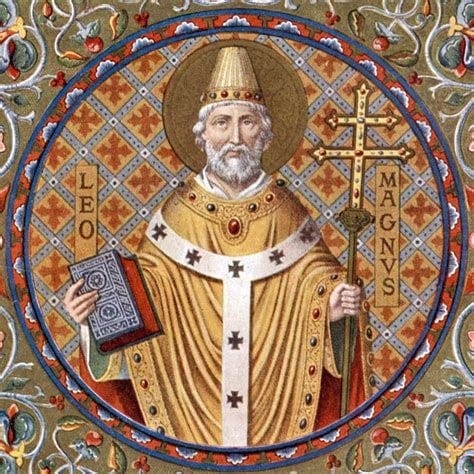Daily Readings | 18 Feb 25 | Love for Our Brethren; Judas' Betrayal, the Last Supper, and Gethsemane
Scripture Readings: 1 John 3:10–20; Mark 14:10–42
I have decided to attempt doing a short reflection on the Byzantine Church’s daily readings when I am able. We will see how long this lasts, but I hope to keep me (and hopefully you) reading and contemplating Scripture.
These daily reflections are more of what am thinking when I read through these texts. I will put in hardly any research—if any at all. These should be read in that spirit: what do I find interesting and wish to discuss in the moment, and what happened to pop in my head.
Feast Day: Leo the Great, Pope (I accidently read the wrong Feast Day yesterday; that has been corrected)
Readings: 1 John 3:10–20; Mark 14:10–42
For today’s readings, there is a lot that is covered. The 1 John passage is brief, but there is a comment I would like to make on it. As for Mark, there is a significant amount of deep, theologically important verses that would take far too much space to do here.
As such, I will provide a comment on 1 John concerning parallel passages in John—including the expansion by the epistle writer—and (potentially) Matthew.
I will also comment a bit on Mark, but with Pascha approaching, I believe a more detailed post on the Last Supper should be reserved for a later time.
How to Love One Another
There are numerous parallels with the other Gospels contained in this reading today. My focus will concern vv. 15–18,
|15| Any one who hates his brother is a murderer, and you know that no murderer has eternal life abiding in him. |16| By this we know love, that he laid down his life for us; and we ought to lay down our lives for the brethren. |17| But if any one has the world’s goods and sees his brother in need, yet closes his heart against him, how does God’s love abide in him? |18| Little children, let us not love in word or speech but in deed and in truth.
Hatred Towards our Brethren (Matthew)
Starting with v. 15, there is a clear resonance here with the teachings of Jesus. In Matthew’s Sermon on the Mount, Jesus expounds on the Law, speaking about what it means to have anger towards your brother:
|21| You have heard that it was said to the men of old, “You shall not kill; and whoever kills shall be liable to judgment.” |22| But I say to you that every one who is angry with his brother shall be liable to judgment… (Matt 5:21–22a)
This could be an indication that the author of 1 John knows Matthew’s Gospel. There is no exact verbal parallel here, but the conceptual similarity is notable.
It is a reminder, both in Matthew and 1 John, that we should regulate how we feel towards others, especially those in the body of Christ. We should not harbor hatred or disdain towards another, because we will be “liable to judgment,” and it is a tacit indicator that we do not have “eternal life abiding in [us].”
No matter how someone wrongs us, no matter how slighted we may feel, it is best to resolve the hatred in our own hearts so that we might be worthy to receive.
To Lay Down Our Lives for Another (John)
In John’s Gospel, Jesus describes himself as the Good Shepherd (10:1–21). Jesus states five times how he will lay down his life for his sheep:
The good shepherd lays down his life for the sheep (v. 11)
as the Father knows me and I know the Father; and I lay down my life for the sheep (v. 15)
For this reason the Father loves me, because I lay down my life, that I may take it again (v. 17)
No one takes it from me, but I lay it down of my own accord (v. 18a)
I have power to lay it down, and I have power to take it again; this charge I have received from my Father (v. 18b)
It is a striking and memorable section of the Gospel according to John. Here, 1 John is certainly riffing on this repeated line in John 10; he even expands on it and insists that we—as believers—should be willing to do the same for each other.
A striking remark, especially considering Jesus had the “power to take it again,” whereas we do not.
The Sheep and the Goats? (Matthew)
Although this final parallel is certainly a stretch for 1 John’s intent—meaning, I do not believe he had this passage in mind—there is a similar thought present in both.
In Matt 25:31–46, Jesus speaks in a parable of when the Son of Man comes in his glory, there will be a separation of the sheep and the goats. The sheep are those who took care of others, and they are rewarded. Conversely, the goats neglected their good deeds towards their fellow man, and they are punished.
After speaking of the sheep, the parable reads,
And the King will answer them, “Truly, I say to you, as you did it to one of the least of these my brethren, you did it to me.” (Matt 25:40)
The implication being, their good deeds toward others gained them their reward. The King prior to v. 40 states,
|35| for I was hungry and you gave me food, I was thirsty and you gave me drink, I was a stranger and you welcomed me, |36| I was naked and you clothed me, I was sick and you visited me, I was in prison and you came to me. (Matt 25:35–36)
So, not exactly reliant on Jesus’ parable in Matthew, we can certainly see a similar attitude towards the poor, the destitute, and those who are in need.
We should remember to take care of those who are less fortunate than ourselves, for it is our duty, based both on 1 John and Matthew. As these brief verses imply in 1 John, we should be willing to do anything and everything for those in the Church—and for those outside her, which is not a difficult extrapolation.
The Last Supper & Gethsemane
I have recently just written on the wine at the end of the Last Supper in Mark’s Gospel, so I will refrain from repeating myself here. As for the actual words of institution, I am developing a longer project on bread, which will eventually include this passage—noting the parallels here with the feedings of the 5 and 4,000.
Rather, I would like to show some pictures from Israel, specifically from the Garden of Gethsemane.
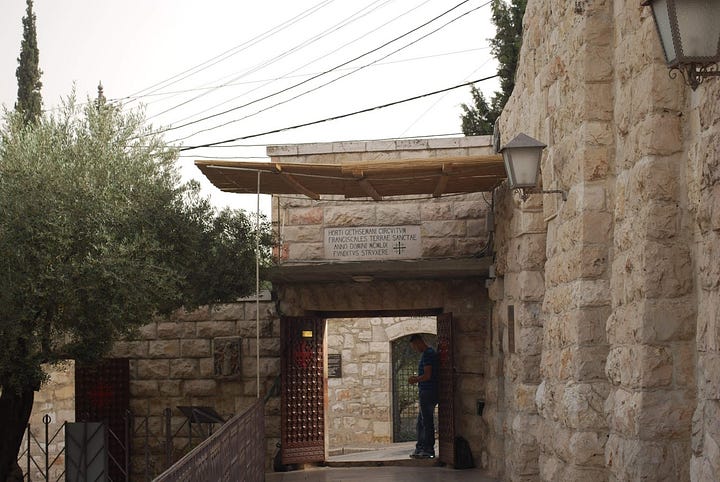
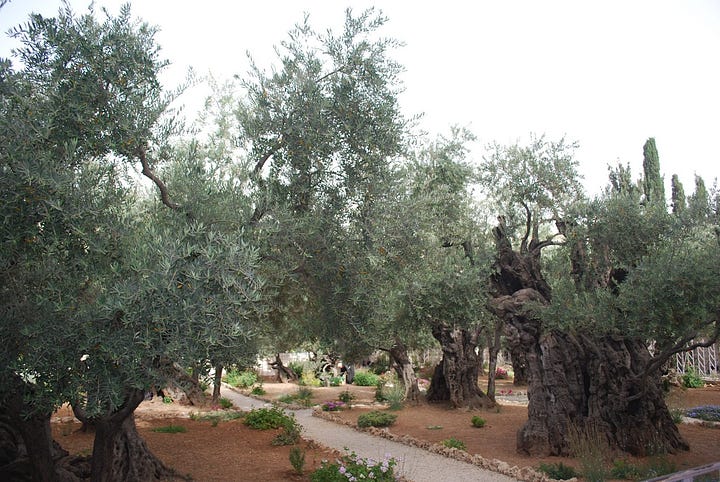
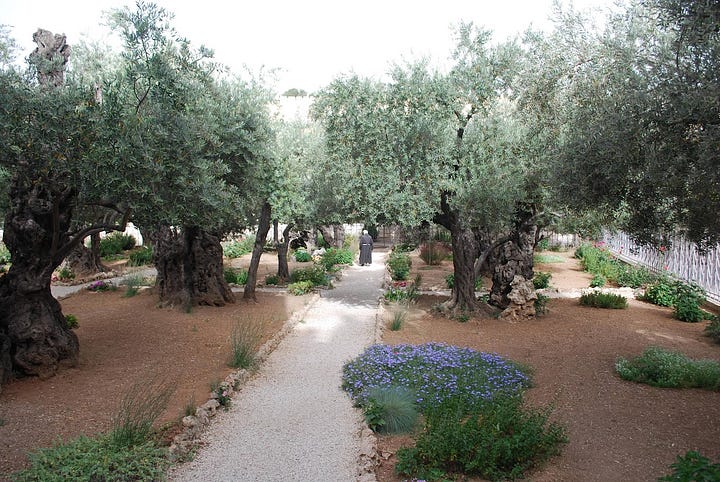
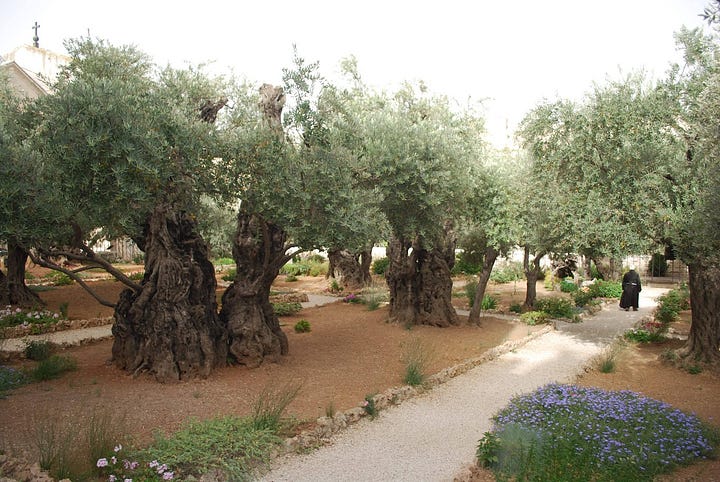
It is a beautiful, peaceful garden filled with olive trees and other vegetation. There is a Church—Catholic Church of All Nations—built over the “Rock of Agony,” which is where it is believed that Christ prayed.
One point of narrative exegesis in Mark, it is intriguing when Jesus prays in the garden:
And he said, “Abba, Father, all things are possible to thee; remove this cup from me; yet not what I will, but what thou wilt.” (14:36)
This has an exact lexical and thematic resonance from earlier in the Gospel when James and John make a bold request:
Grant us to sit, one at your right hand and one at your left, in your glory (ἐν τῇ δόξῃ). (10:37)
Jesus replies to them, stating,
“You do not know what you are asking. Are you able to drink the cup that I drink (10:38)
In both accounts, the word is ποτήριον, “cup.” Jesus knows in chapter 10 what his ultimate fate is,—the crucifixion—and here, in Gethsemane, he knows it approaches rapidly.
His request is an appeal back to James and John’s. The word is meant to resonate in the readers head that Jesus will soon come into his glory. He will soon be mockingly coronated and nailed on a cross—his throne—with two others “seated” on his left and on his right.
Concluding Thoughts
Reading through 1 John, we can see the potential influences on the text, from the Gospels of Matthew and John.
The resonate themes and language helps show the interdependence on early Christian writers, that they were reading each other and developing their own thought.
Ultimately, it should be gained from these texts that what we do matters. We are to take care of one another because we are fulfilling our duties as members of Christ’s Church.
If you have enjoyed this brief reflection on today’s (Byzantine) readings and wish to read more about NT studies, would you kindly share this post and subscribe.




